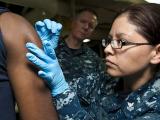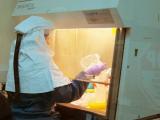Oct 26, 2001 (CIDRAP News) The Centers for Disease Control and Prevention (CDC) gives a detailed report on its ongoing investigation of the current anthrax attack in today's issue of Morbidity and Mortality Weekly Report. The report includes a detailed treatment protocol for inhalational anthrax related to the current attack, calling for use of either ciprofloxacin or doxycycline plus one or two other antimicrobials.
"Because of the mortality associated with inhalational anthrax, two or more antimicrobial agents predicted to be effective are recommended," even though controlled studies to support a multidrug approach are lacking, the report says. In the Oct 19 issue of MMWR, the CDC recommended using either ciprofloxacin or doxycycline alone for postexposure prophylaxis against anthrax. Additional agents suggested in the new reportdespite limited data on their useinclude rifampin, vancomycin, imipenem, chloramphenicol, penicillin, ampicillin, clindamycin, and clarithromycin.
The new report also advises that people with cutaneous anthrax related to the current attack receive ciprofloxacin or doxycycline for 60 days instead of the 7 to 10 days usually recommended, because the risk of simultaneous aerosol exposure in the present situation appears high.
As of the evening of Oct 24, 11 confirmed and 4 suspected cases of anthrax had been identified in Washington, DC, Florida, New York City, Maryland, Pennsylvania, and Virginia, the CDC reports. Seven cases were inhalational and eight were cutaneous. Of the 7 inhalational cases, 5 occurred in postal workers in New Jersey and Washington and 2 at a media company in Florida. Two letters mailed to two different recipients in New York City and one mailed to Washington are known to have contained Bacillus anthracis spores, the report states, adding, "Using molecular typing, analysis of B anthracis isolates from cases in Florida, NYC, and DC indicated that the isolates are indistinguishable."
By location, the cases investigated as of publication of the MMWR report included the following:
Florida: Two confirmed cases of inhalational anthrax in men who worked at the same media company, as described in the previous MMWR report of Oct 19.
New York: Three confirmed and two suspected cases of cutaneous anthrax. Two of the confirmed cases and one suspected case were identified since the previous MMWR report. The five cases were associated with four media companies. The three patients with new cases have all improved with treatment, the report says.
New Jersey and Pennsylvania: Three cases of cutaneous anthrax and one case of suspected inhalational anthrax, all in postal workers. The three patients with cutaneous anthrax were improving, while the patient with inhalational anthrax had bilaterial pleural effusions and was on supplemental oxygen, the CDC reports.
Washington, DC: Four confirmed cases of inhalational anthrax, all in people who worked at the same postal facility. Two of these, both 56-year-old men, were hospitalized and in stable condition as of Oct 24. A 55-year-old man died Oct 21, and a 47-year-old man died Oct 22. Both men had been sent home after initial medical visits and later had sought treatment again for continuing or worsening symptoms, the report says. Both died within hours after seeking treatment the second time.
The CDC also reports on antimicrobial susceptibility testing of the B anthracis organisms used in the current attack. All the isolates were susceptible to ciprofloxacin, doxycycline, chloramphenicol, clindamycin, tetracycline, rifampin, and vancomycin. Isolates were also susceptible to penicillin and amoxicillin, the agency says. In treatment recommendations designed specifically for the present anthrax attack, the report says cephalosporins and trimethoprim-sulfamethoxazole should not be used, nor should penicillins be used alone.
The report also includes guidance on how to spot and handle suspicious packages.
CDC. Update: investigation of bioterrorism-related anthrax and interim guidelines for exposure management and antimicrobial therapy, October 2001. MMWR 2001(Oct 26);50(42):909-19
http://www.cdc.gov/mmwr/preview/mmwrhtml/mm5042a1.htm
See also:
CDC Web page with guidance on anthrax identification for clinicians and laboratorians and other resources on anthrax:
http://www.bt.cdc.gov




















